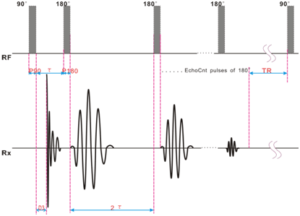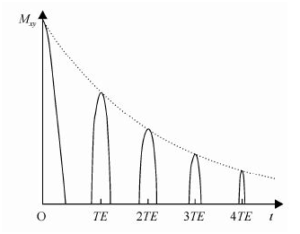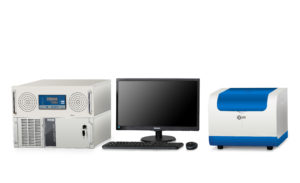Although FID experiment is useful for setting upNMR instrumentation, it has some disadvantages. The main disadvantage is that the decay constant (or shape) of data acquired with FID is affected not only by the sample properties, but also the homogeneity (or uniformity) of the magnetic field over the sample. Most scientists are only interested in the influence of sample properties on the NMR data, so removing the effect of the magnetic field on the decay of the NMR data would be extremely useful. Fortunately, the effects of the magnet on the signal can be removed by using a special pulse sequence called CPMG sequence.

Higo 1: CPMG sequence
CPMG sequence is one of the important means to measure transverse relaxation time of the sample. The CPMG sequence involves applying not a single 90 degree RF pulse to the sample, but many 180 degree pulses. Each time a 180 degree pulse is applied, the signal decay to the magnetic field is removed and a single data point is acquired. The decay of the data thus only reflects the sample properties and for liquids is exponential in nature (a distribution). The decay constant of the exponential is called (el tiempo de relajación spin-spin) or the transverse relaxation time.

Higo 2: CPMG sequence Echo
The parameters of this sequence are listed below.
Mesa 1: The parameters of CPMG sequence
|
P1 |
the width of 90-degree RF pulse |
| DL1 | Delay 1, time interval between 90 degree pulse and adjacent180 degree pulse; time interval between 180 degree pulse and adjacent 180 degree pulse is 2*DL1 |
| P2 | the width of 180-degree RF pulse |
| TW | the waiting time between two scans of sampling data |
| EchoCnt | Number of 180 degree RF pulse |
| RFD | Time interval between 90 degrees RF and the beginning of signal acquisition |
| Peaks parity | the inversion of sampling points |
In the tests, the value of τ is set to be 1000μs and only the signal of the first echo, which mainly contains the signal of oil due to the almost complete decaying of fibred signal, needs to be applied. What’s more, the signal of echo is more stable than that acquired by FID sequence and is less influenced by the outside environment. Por lo tanto, this sequence is regarded as the first choice of NMR detection. Sin embargo, the τ value and echo number will change with different samples.
 mohoso
mohoso
